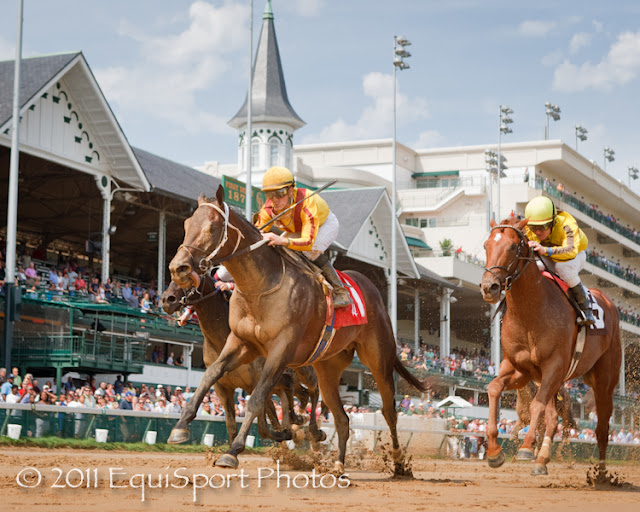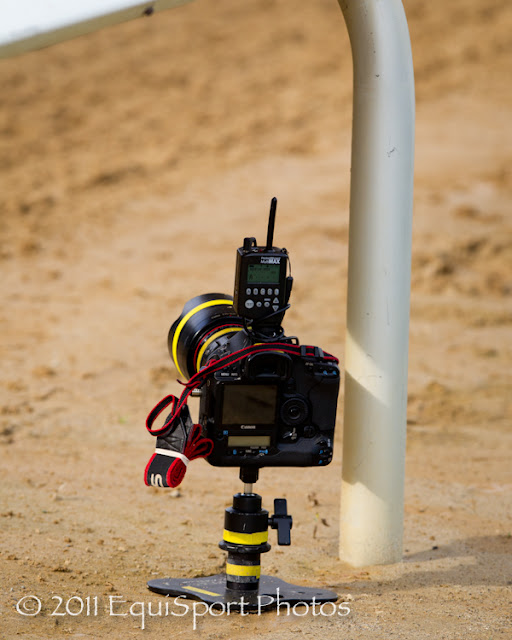The short answer is "Just stick your camera in the dirt, and fire it with a remote".
 |
| Giant Oak (outside) wins the Clark H. at Churchill 10.26.2010. Manual priority, 1/1000 @ f/3.2, iso1250, 200mm |
And me just being me, I wanted to challenge myself to get something a little different... so I brought out the whole kit.
 |
| Dr. Ballenger wins at Churchill 6.18.2011. Photo: Matt Wooley, Shutter Priority, 1/1600 @ iso500, f/4.5, +2/3ev, 200mm. |
My buddy Alex Evers, a contributor here on CTL Equine, got me started on "remotes" a few years ago. Seeing some of his unique perspectives got me hooked on the possibilities of placing cameras in some unusual spots. Like under the rail at the race track. Or in the starting gate. Or in the overhead trellis at a wedding!
Having the ability to use remotes gives you the chance to get the action from multiple cameras, and therefore multiple perspectives. The photo below frames an iconic backdrop at Churchill Downs.
 |
| Dr. Ballenger wins at Churchill 6.18.2011. Photo: Matt Wooley, Shutter Priority, 1/3200 @ iso800, f/4.5, +2/3ev, 50mm |
The possibilities are endless. If you can stuff a camera in a spot, you should be able to get a picture from that perspective.
 |
| Dr. Ballenger at Churchill 6.18.2011. Photo: Matt Wooley, Shutter Priority, 1/3200 @ iso800, f/4.5, +1/3ev, 15mm fisheye. |
Have I mentioned I'm a "Home run, or Ground Out" kind of shooter? I'm always swinging for the fence. In this case, we both got really nice tight shots... of the second place horse. Ground out. The remotes saved us!
So here's the set-up. Most of the time I will use a set of Pocket Wizards. These units can be set to send or receive a radio signal from another Pocket Wizard.
 | |
| Pocket Wizard "Multi-Max" in the Receiving camera's hot shoe. |
The other Pocket Wizard can be mounted in another camera hot shoe, and will trigger as the other camera fires, or it can be triggered by hand.
This photo is in our back yard, with the cameras about 3 feet away from each other, but the range for Pocket Wizards is supposed to be 1600 feet. Not too sure I would count on that distance, but they are definitely reliable from the other side of the race track.
I tend to hold the triggering PW in my left hand, because I don't always want the remote to fire every time I hit my hand held. Plus, I'm usually firing cameras that have different frame-per-second firing rates.
Here's what the set up looked like last Saturday at the track...
The first photo was taken with the 2-camera set-up. Both are set at 200mm, one is an "innie" and one is an "outie", so I should get a nice tight frame wherever the horses run on the track. Got it with the "outie" this time since the horse ran wide. Did I mention that I missed it with my hand held?
The third shot was taken with the fisheye. I used a Magic Arm clamped near the finish line.
Tip: Do Not clamp to the mirror or any timing devices at the track...lol.
This Magic Arm and Super Clamp will go about anywhere you can imagine. Like on the starting gate, or the photographer's stand. Or above the trellis at a wedding...
Or under a Steeplechase jump...
 |
| Steeplechase at Ky. Horse Park. Photo: Matt Wooley, Shutter Priority, 1/2000 @ iso500, f/4.5, +1/3ev, 16mm. |
One of the keys for remotes is setting a focal plane. I pre-focus on a point at which I think the action will occur. Switch the lens off to Manual Focus, so it does not try to Auto-focus during the shot. Then fire on Burst Mode as the action occurs. In horse racing, if I'm preset on the finish line, I'll fire a burst of about 30 frames (at 10 frames per second) as they cross the wire. My goal is to get 2 or 3 frames that are sharp, enabling me to pick good foot position.
To get started you will need, at minimum, 2 Pocket Wizard Plus II and a Release Cable (for Canon). Total investment about $450. An upgrade to the PW's that I like, is the Pocket Wizard Multi-Max.
At big events we "hard wire" the remote cameras using lamp cable, since there is so much radio interference from cell phones and TV transmission, but the Pocket Wizards are good for 90% of the time.
We love to hear your comments! Or if you have a question, and I will try to answer it.
 |
| Photo: Alex Evers. |
We had such positive response from our Spring Workshop, we are doing it again November 1-3. Conveniently planned for the week before the Breeder's Cup, this class will be limited to 9 participants with 3 EquiSport instructors. We will visit some pretty cool spots in the Bluegrass for equine photography, like Old Friends, Keeneland, Kenny McPeek's training center, and Spendthrift Farm. Check out the details and drop us a line!






Love the shots of Dr. Ballanger. That was a good ride Leparoux put on him.
ReplyDeleteLove your work,can you please explain more about focus?how do you do it. and which exposures to use as the day goes on from light to dark?
ReplyDelete